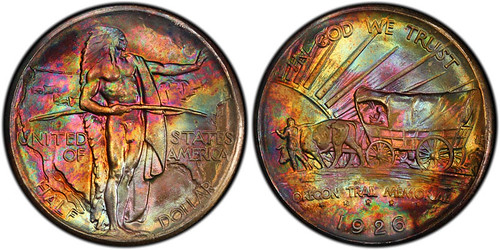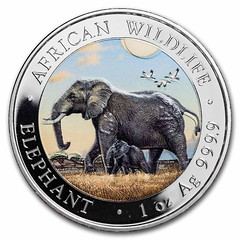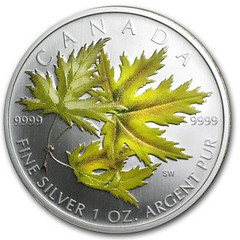
PREV ARTICLE
NEXT ARTICLE
FULL ISSUE
PREV FULL ISSUE
TONED AND COLORIZED COINSLast month COINage had an article by Mike Garofalo on the history of toned and colorized coins. Here's an excerpt - see the complete article online. -Editor The popularity of coins with color on them drives certain segments of rare coin markets and collectors. Morgan Dollars, type coins, and classic commemoratives are all distinct types of numismatic coins where beautiful and original colors bring strong premiums. An ever-growing segment of the coin market appreciates natural color on coins. Non-collectors are also attracted to the colorful images, even though the coins are secondary. In April 2004, Superior Galleries offered a beautifully toned 1926 Oregon Trail Commemorative Half Dollar, graded MS67, at a public auction in California. The coin brought $69,000. That's 34.5 times its graded value of $2,000. Why? Because of the coin's beautiful, natural and original color.
Later, people began applying stickers, or appliques, to cover one side of the coin with a colorful image of the coin itself or something completely different. While these stickers were not as attractive as a hand-painted product, the stickers satisfied the demands of a mass audience. Enterprising organizations began adding artificial color to the surface of the coin. The first colorized coins offered to the public were struck by Coin Invest Trust (CIT), a private mint in Europe after they developed a chemical and mechanical process for adding color to the coins. This process allowed them to bond the color to the metal.
Since that time, the Royal Canadian Mint has utilized that technology on numerous occasions to create different colorized coins. Some of the most popular coins have been the colorized Maple Leaf silver bullion coins, with their bold, bright and seemingly natural colors. Many people wondered when and if the United States Mint would create and issue a colorized coin. In August 2020, the Mint released a colorized coin set for the 60th Anniversary of the Naismith National Basketball Hall of Fame. These commemorative coins were truly an innovation for the ‘late-joining' U.S. Mint.
To read the complete article, see:
Wayne Homren, Editor The Numismatic Bibliomania Society is a non-profit organization promoting numismatic literature. See our web site at coinbooks.org. To submit items for publication in The E-Sylum, write to the Editor at this address: whomren@gmail.com To subscribe go to: https://my.binhost.com/lists/listinfo/esylum All Rights Reserved. NBS Home Page Contact the NBS webmaster 
|



